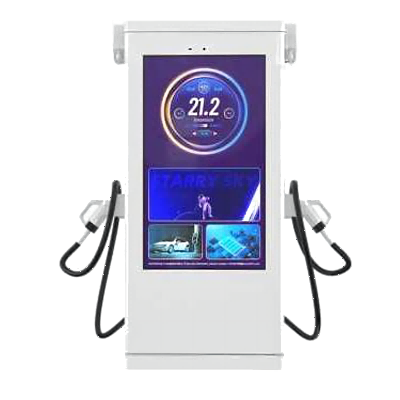





Floor-Mounted 2 Guns Advertising DC EV Charger
Discover the advanced 2 Guns DC EV Charging Stations, offering power outputs from 60kW to 120kW, ideal for rapid charging your electric car.
These innovative DC EV charging stations also double as advertising charging stations, reshaping the landscape of electric vehicle charging advertising. Experience the future of EV charging advertising with the 2 Guns EV DC Charging Stations.
- IP54
- 32 inch AD screen
- Full Protection
Charging Power
- Detailed Specifications
- Rated power:60kW-240kW
- Input current:45A-95A
- Gun quantity:2
- Cable length:5M or customized length
- Network connection:Standard configuration:CAN/485/Ethemet Selective:GPRS/4G/WIFI
- Operating temperature:-20C-+50C
- Operation Humidity:5%6-90%RH,non-condensiong
- Input voltage:260V-480V
- Output current:100-200A
- Charging way:Charge alternately/evenly
- AD screen:32 inch advertising screen/wifi
- Size(mm):900X270X1800
- Altitude:2000M
- Standard:Europe standards(CCS):EN61851,EN62196
- Output voltage:200-750V(200-1000V)
- Frequency:45~60 HZ
- Charging mode:Plug and play/RFID/OCPP
- Interface:7" color touch screen+C card contacless card reader
- Weight:250KG
- IP level:IP54
- Protocol:China standards(GB/T):27930;Europe standards(CCS):DlN70121 1S0 15118;Japan standards :Chademo 2.0
Efficiencyimprovement and cost
- Integrate the 32"AD screen with charger,widen your incomes,
Safe and reliable
- Protection grade up to lP54,moisture-proof,water-proof,condensening proof,dust proof and flame retardant.
- With over and under voltage,overload,short circuit,leakage.battery anti-reverse protection,ect.
- IK10 anti-collision
High integration
- The product integrates power conversion, charging control,human-computerinteraction control, communication,and billing system.
Ultra-Fast Charging
- Our high - power DC charging product is equipped with an intelligent charging adaptation system. It can instantly identify the battery type, power status, and charging requirements of the connected vehicle and automatically match the most suitable charging mode. Whether it is a common ternary lithium - ion battery or a lithium iron phosphate battery, it can be efficiently adapted. In practical applications, the charging process can be optimized for different vehicle models, and the overall charging efficiency can be increased by 30%. It truly achieves a one - vehicle - one - strategy approach, providing flexible charging and bringing you a convenient and efficient charging experience.
Globally-Compatible Custom Services
- Our DC chargers, designed by our professional team, support multiple global electric vehicle charging standards such as designed by our professCCS, CHAdeMO, and Tesla Supercharger. Our products meet international certification standards, and through customized energy conversion technologies, we improve battery charging efficiency to customized energy conversion technologies, we improve battery charging efficiency to 98%, ensuring efficient and safe electric vehicle charging services worldwide.
Efficient After - sales Service
- We have a professional and flexible service team that provides full - process services from product planning to later operation and maintenance. During the product planning stage, senior industry experts will communicate with you in depth to fully understand your operation mode, site conditions, and future development plans. The installation service is led by professional engineers with an average working experience of over 5 years. They will carry out precise construction based on the previous plan, enabling your charging facilities to quickly and accurately meet the actual operation needs. In the after - sales stage, we will assign a dedicated after - sales team to provide one - to - one service for you. We will provide you with a personalized equipment maintenance plan every year to ensure that the equipment is always in the best operating condition and make your operation worry - free.
Explore our wider range of charging products
Our success stories
From homes to commercial spaces, from cities to remote areas, witness how we drive the growth of the EV charging sector with exceptional products and services.
EV Charging Resources

What Will Charging Stations Look Like in 2040?
By 2040, EV charging infrastructure will be widespread, intelligent, and sustainable. Charging stations will integrate seamlessly into urban environments (lampposts, roads) and prioritize ultra-fast speeds (350kW+), smart grids, and vehicle-to-grid (V2G) energy exchange. Renewable energy adoption, megawatt charging for trucks, and wireless solutions will dominate, while businesses shift to subscription models and data-driven services. Enhanced safety protocols, cybersecurity, and reliability ensure seamless, eco-friendly charging, supporting a cleaner, grid-responsive future.

How Can Charging Stations Guard Against Cyber Attacks?
As electric vehicle (EV) charging stations proliferate, they become prime targets for cyberattacks due to grid connectivity and data vulnerabilities. Risks include ransomware, data breaches, grid destabilization, and reputational damage. Mitigation requires layered security: encrypted communication, network isolation, regular updates, physical safeguards, and adherence to certifications like ISO 21434 and NIS2. Shared responsibility among operators, manufacturers, users, and regulators is crucial. Emerging technologies like AI and blockchain enhance threat detection and data integrity. Proactive measures and compliance ensure secure EV charging ecosystems amid evolving cyber threats.

How to choose between EV and ICE?
Choosing between EVs and ICE vehicles hinges on operational needs, budgets, and sustainability goals. While EVs offer long-term savings, reduced emissions (zero tailpipe pollution), and lower fuel/maintenance costs, ICE vehicles provide faster refueling and heavy-duty capabilities. Enterprise fleets must assess routes (mileage, downtime), vehicle types (light vs. heavy-duty), financial incentives, and charging infrastructure (Level 2, DC fast charging). Total Cost of Ownership (TCO) analysis shows EVs’ long-term affordability despite higher upfront costs. Emerging trends like solid-state batteries, V2G tech, and autonomous driving signal EV dominance. Planning charging infrastructure and leveraging grants ensure a smooth transition.

How are Disputes Resolved Over Community-Shared Charging Piles?
Conflicts over shared EV charging often stem from charger hogging, unauthorized use, equipment damage, cost disputes, and accessibility issues. Clear communication with signage, meetings, and updates minimizes misunderstandings. Technology like charging software, RFID access, and apps enables scheduling, billing, and real-time monitoring. Formal dispute processes include mediation, arbitration, or legal action. Fair policies require energy assessments, rules for usage/costs, accessibility compliance, and regular reviews. Transparency in billing and data integration enhances consumer protection, ensuring equitable charging for all residents.
get a tailored OEM solution
- Comprehensive OEM solutions
- Safe and reliable chargers
- Cost-effective options
- Suitable for all types of businesses
